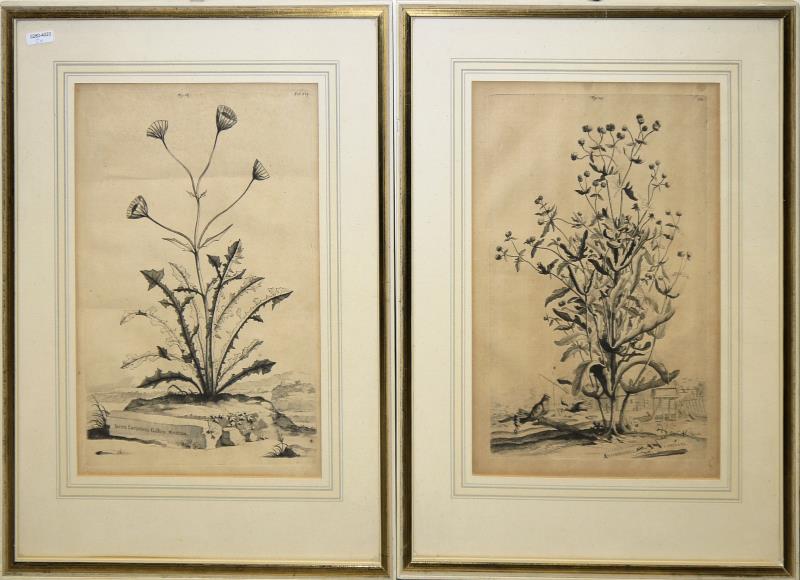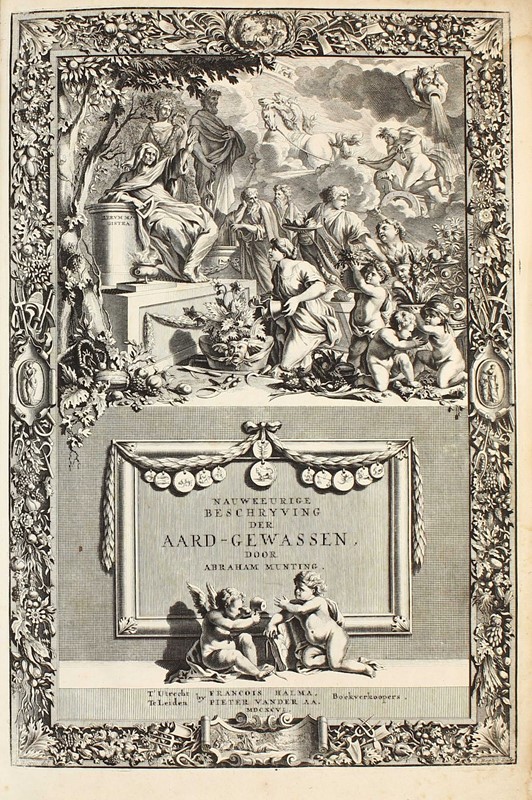ABRAHAM MUNTING (1626-1683)] An album of plant drawings. Circa 1672-1696]. 2° (400 x 310mm). 176 mounted pen-and-ink and wash botanical drawings, most monochrome with occasional traces of underdrawing in red or black chalk, plant names in Latin and paper additions glued to lower edge, the final 16 coloured, one of these (number 167) signed with monogram 'HB' or IHB fec.'. Early-19th-century half sheep, spine in five compartments with raised bands, the bands delineated with gilt rules, the second compartment with red morocco lettering-piece with rule and roll-tool decoration surrounding titling 'Plantes Dessinées'. Provenance : Abraham Munting (1626-1683, manuscript titles to most drawings, probably inherited by his son:); Albert Munting (1660-1694); ?F.Halma and P. van der Aa (printers, pencilled notes on verso of some drawings and mounts); pencilled note in an unidentified hand (on front pastedown, noting an auction in 1821). A FINE UNRECORDED COLLECTION OF DRAWINGS, ORIGINALLY COMMISSIONED OR COLLECTED BY MUNTING, WITH ALL BUT TWO USED TO ILLUSTRATE ONE OF MOST ALLURING OF 17TH-CENTURY BOTANICAL WORKS, Munting's posthumous publication Naauwkeurige Beschryving der Aardgewassen (Leiden & Utrecht: F.Halma & P.van der AA, 1696). Neither the copperplates nor Munting's manuscript are known to have survived. This corpus of drawings has only just been discovered; its very existence has been unknown to scholars of Munting's work. These images, some of the finest botanical illustrations of their time, represent 'a radical departure from the iconography of then traditional florilegium... Each plate shows a different plant in flower, including many exotic species from America and other distant lands. The plant dominates the foreground, filling the entire page, often with a detail of the fruit or the flowers presented on a smaller scale. In some cases the plants are presented à trompe l'oeil , while in others they have been arranged in decorated urns. Sometimes gardening tools are depicted as well. The name of each plant appears written on an elegantly fluttering ribbon or cartouche, or on a crumbling marble plaque. 'The originality of the work lies, however, in the small landscapes that have been inserted into the background of the plates. Here the artist gave full rein to his imagination, delineating scenes that in reality bore little relation to the actual habitat of the plants. Pastorals with animals and figures alternate capriously with vistas of walled cities and landscapes containing classical statues and ruins' (Lucia Tongiorgi-Tomaso An Oak Spring Flora p.174). Although Tongiorgi-Tomaso goes on to say 'it is not known who actually conceived this idea of combining botanical illustration with landscape scenes'. These drawings reveal exactly how and why these remarkable images were created. The detailed and careful drawings demonstrate that each image is the work of two artists, and allow the viewer to see clearly how a collection of normal scientific line drawings by various hands, a number not intended for publication, have been transformed into a cohesive and spectacularly artistic grouping incorporating shading, ribbons for captions and landscape backgrounds, ready for use as models for the engraver. Hendrik Munting (1583-1658) founded in 1642 a botanical garden situated within the fortification circuit of Groningen known as the 'Paradise of Groningen', with its hothouses and forcing frames. It was famous thoughout Europe and a place of horticultural pilgrimage. His son, Abraham, director of the garden from 1658 and professor of Botany at the university of Groningen, assembled the present collection of drawings. During his lifetime three of the drawings (nos. 15, 116, 138) were used as models for illustrations in his Waare Oeffening der Planten (Amsterdam: Jan Rieuwertsz, 1672, 4°, 40 plates; 2nd edition: 1682), a further five (nos. 2, 3, 89, 149, 150) in his Aloidarium... historia (Amsterdam: 1680, 4°, 8 plates) and 12 i
ABRAHAM MUNTING (1626-1683)] An album of plant drawings. Circa 1672-1696]. 2° (400 x 310mm). 176 mounted pen-and-ink and wash botanical drawings, most monochrome with occasional traces of underdrawing in red or black chalk, plant names in Latin and paper additions glued to lower edge, the final 16 coloured, one of these (number 167) signed with monogram 'HB' or IHB fec.'. Early-19th-century half sheep, spine in five compartments with raised bands, the bands delineated with gilt rules, the second compartment with red morocco lettering-piece with rule and roll-tool decoration surrounding titling 'Plantes Dessinées'. Provenance : Abraham Munting (1626-1683, manuscript titles to most drawings, probably inherited by his son:); Albert Munting (1660-1694); ?F.Halma and P. van der Aa (printers, pencilled notes on verso of some drawings and mounts); pencilled note in an unidentified hand (on front pastedown, noting an auction in 1821). A FINE UNRECORDED COLLECTION OF DRAWINGS, ORIGINALLY COMMISSIONED OR COLLECTED BY MUNTING, WITH ALL BUT TWO USED TO ILLUSTRATE ONE OF MOST ALLURING OF 17TH-CENTURY BOTANICAL WORKS, Munting's posthumous publication Naauwkeurige Beschryving der Aardgewassen (Leiden & Utrecht: F.Halma & P.van der AA, 1696). Neither the copperplates nor Munting's manuscript are known to have survived. This corpus of drawings has only just been discovered; its very existence has been unknown to scholars of Munting's work. These images, some of the finest botanical illustrations of their time, represent 'a radical departure from the iconography of then traditional florilegium... Each plate shows a different plant in flower, including many exotic species from America and other distant lands. The plant dominates the foreground, filling the entire page, often with a detail of the fruit or the flowers presented on a smaller scale. In some cases the plants are presented à trompe l'oeil , while in others they have been arranged in decorated urns. Sometimes gardening tools are depicted as well. The name of each plant appears written on an elegantly fluttering ribbon or cartouche, or on a crumbling marble plaque. 'The originality of the work lies, however, in the small landscapes that have been inserted into the background of the plates. Here the artist gave full rein to his imagination, delineating scenes that in reality bore little relation to the actual habitat of the plants. Pastorals with animals and figures alternate capriously with vistas of walled cities and landscapes containing classical statues and ruins' (Lucia Tongiorgi-Tomaso An Oak Spring Flora p.174). Although Tongiorgi-Tomaso goes on to say 'it is not known who actually conceived this idea of combining botanical illustration with landscape scenes'. These drawings reveal exactly how and why these remarkable images were created. The detailed and careful drawings demonstrate that each image is the work of two artists, and allow the viewer to see clearly how a collection of normal scientific line drawings by various hands, a number not intended for publication, have been transformed into a cohesive and spectacularly artistic grouping incorporating shading, ribbons for captions and landscape backgrounds, ready for use as models for the engraver. Hendrik Munting (1583-1658) founded in 1642 a botanical garden situated within the fortification circuit of Groningen known as the 'Paradise of Groningen', with its hothouses and forcing frames. It was famous thoughout Europe and a place of horticultural pilgrimage. His son, Abraham, director of the garden from 1658 and professor of Botany at the university of Groningen, assembled the present collection of drawings. During his lifetime three of the drawings (nos. 15, 116, 138) were used as models for illustrations in his Waare Oeffening der Planten (Amsterdam: Jan Rieuwertsz, 1672, 4°, 40 plates; 2nd edition: 1682), a further five (nos. 2, 3, 89, 149, 150) in his Aloidarium... historia (Amsterdam: 1680, 4°, 8 plates) and 12 i













Try LotSearch and its premium features for 7 days - without any costs!
Be notified automatically about new items in upcoming auctions.
Create an alert